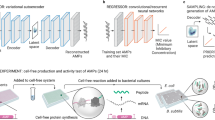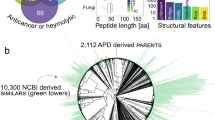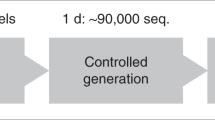Abstract
Bioinspired materials based on self-assembling peptides are promising for tackling various challenges in biomedical engineering. While contemporary data-driven approaches have led to the discovery of self-assembling peptides with various structures and properties, predicting the functionalities of these materials is still challenging. Here we describe the deep learning-guided de novo design of antimicrobial materials based on self-assembling peptides targeting bacterial membranes to address the emerging problem of bacterial drug resistance. Our approach integrates non-natural amino acids for enhanced peptide self-assembly and effectively predicts the functional activity of the self-assembling peptide materials with minimal experimental annotation. The designed self-assembling peptide leader displays excellent in vivo therapeutic efficacy against intestinal bacterial infection in mice. Moreover, it exhibits an enhanced biofilm eradication capability and does not induce acquired drug resistance. Mechanistic studies reveal that the designed peptide can self-assemble on bacterial membranes to form nanofibrous structures for killing multidrug-resistant bacteria. This work thus provides a strategy to discover functional peptide materials by customized design.
This is a preview of subscription content, access via your institution
Access options
Access Nature and 54 other Nature Portfolio journals
Get Nature+, our best-value online-access subscription
$32.99 / 30 days
cancel any time
Subscribe to this journal
Receive 12 print issues and online access
$259.00 per year
only $21.58 per issue
Buy this article
- Purchase on SpringerLink
- Instant access to full article PDF
Prices may be subject to local taxes which are calculated during checkout






Similar content being viewed by others
Data availability
The data that support the findings are available within the main text and the Supplementary Information and can be obtained from the corresponding authors upon request. The positive pretrained dataset was collected from the DBAASP database (https://dbaasp.org/search). The negative pretrained dataset was collected from the UniProt database (http://www.uniprot.org). Datasets and codes for the model are accessible via Science Data Bank at https://doi.org/10.57760/sciencedb.19186 (ref. 46). Source data are provided with this paper.
Code availability
The TransSAFP model can be accessed via GitHub at https://github.com/LiuHuayang27/TransSAFP (ref. 47), which is archived at the Science Data Bank at https://doi.org/10.57760/sciencedb.19186 (ref. 46).
References
Ahnert, S. E. et al. Principles of assembly reveal a periodic table of protein complexes. Science 350, aa2245 (2015).
Vermeire, P.-J. et al. Molecular interactions driving intermediate filament assembly. Cells 10, 2457 (2021).
Yang, G. et al. Precise and reversible protein-microtubule-like structure with helicity driven by dual supramolecular interactions. J. Am. Chem. Soc. 138, 1932–1937 (2016).
Imada, K. Bacterial flagellar axial structure and its construction. Biophys. Rev. 10, 559–570 (2018).
Jia, Y. & Li, J. Molecular assembly of rotary and linear motor proteins. Accounts Chem. Res. 52, 1623–1631 (2019).
Chiesa, G., Kiriakov, S. & Khalil, A. S. Protein assembly systems in natural and synthetic biology. BMC Biol. 18, 35 (2020).
Silva, G. A. et al. Selective differentiation of neural progenitor cells by high-epitope density nanofibers. Science 303, 1352–1355 (2004).
Yolamanova, M. et al. Peptide nanofibrils boost retroviral gene transfer and provide a rapid means for concentrating viruses. Nat. Nanotechnol. 8, 130–136 (2013).
Münch, J. et al. Semen-derived amyloid fibrils drastically enhance HIV infection. Cell 131, 1059–1071 (2007).
Kim, J. et al. In situ self-assembly for cancer therapy and imaging. Nat. Rev. Mater. 8, 710–725 (2023).
Baek, M. et al. Accurate prediction of protein structures and interactions using a three-track neural network. Science 373, 871–876 (2021).
Jumper, J. et al. Highly accurate protein structure prediction with AlphaFold. Nature 596, 583–589 (2021).
Guo, J. et al. Cell spheroid creation by transcytotic intercellular gelation. Nat. Nanotechnol. 18, 1094–1104 (2023).
He, P.-P. et al. Bispyrene-based self-assembled nanomaterials: in vivo self-assembly, transformation, and biomedical effects. Acc. Chem. Res. 52, 367–378 (2019).
Gao, J., Zhan, J. & Yang, Z. Enzyme-instructed self-assembly (EISA) and hydrogelation of peptides. Adv. Mater. 32, 1805798 (2020).
Frederix, P. W. J. M. et al. Exploring the sequence space for (tri-)peptide self-assembly to design and discover. Nat. Chem. 7, 30–37 (2015).
Xu, T. Y. et al. Accelerating the prediction and discovery of peptide hydrogels with human-in-the-loop. Nat. Commun. 14, 3880 (2023).
Batra, R. et al. Machine learning overcomes human bias in the discovery of self-assembling peptides. Nat. Chem. 14, 1427–1435 (2022).
Pirtskhalava, M. et al. DBAASP v.2: an enhanced database of structure and antimicrobial/cytotoxic activity of natural and synthetic peptides. Nucleic Acids Res. 44, D1104–D1112 (2016).
Pirtskhalava, M. et al. DBAASP v3: database of antimicrobial/cytotoxic activity and structure of peptides as a resource for development of new therapeutics. Nucleic Acids Res. 49, D288–D297 (2021).
Vaswani A. et al. Attention is all you need. In Proc. 31st International Conference on Neural Information Processing Systems (eds Guyon, I. et al.) 6000–6010 (Curran Associates, 2017).
McInnes, L., Healy, J. & Melville, J. UMAP: uniform manifold approximation and projection. J. Open Source Softw. 3, 861 (2018).
Xu, Z. J. & Zhou, H. Deep frequency principle towards understanding why deeper learning is faster. In Proc. 35th AAAI Conference on Artificial Intelligence (eds. Leyton-Brown, K. et al.) 10541–10550 (AAAI Press, 2021).
Barth, A. Infrared spectroscopy of proteins. Biochim. Biophys. Acta Bioenerg. 1767, 1073–1101 (2007).
Pavia, D. L. et al. in Introduction to Spectroscopy, 5th edn, 70–71 (Cengage Learning, 2015).
Barron, A. R. in Chemistry of the Main Group Elements Ch. 2.7 (Midas Green Innovations, 2014).
el Battioui, K. et al. In situ captured antibacterial action of membrane-incising peptide lamellae. Nat. Commun. 15, 3424 (2024).
Marty, R. et al. Hierarchically structured microfibers of ‘single stack’ perylene bisimide and quaterthiophene nanowires. ACS Nano 7, 8498–8508 (2013).
Kovacs, J. M., Mant, C. T. & Hodges, R. S. Determination of intrinsic hydrophilicity/hydrophobicity of amino acid side chains in peptides in the absence of nearest‐neighbor or conformational effects. Biopolymers 84, 283–297 (2006).
Pane, K. et al. Antimicrobial potency of cationic antimicrobial peptides can be predicted from their amino acid composition: application to the detection of ‘cryptic’ antimicrobial peptides. J. Theor. Biol. 419, 254–265 (2017).
Lopetuso, L. R. et al. Commensal Clostridia: leading players in the maintenance of gut homeostasis. Gut Pathog. 5, 23 (2013).
Zafar, H. & Saier, M. H. Gut Bacteroides species in health and disease. Gut Microbes 13, 1848158 (2021).
Shi, S. H. et al. Multidrug resistant Gram-negative bacilli as predominant bacteremic pathogens in liver transplant recipients. Transpl. Infect. Dis. 11, 405–412 (2009).
Torres, M. D. T. et al. Mining for encrypted peptide antibiotics in the human proteome. Nat. Biomed. Eng. 6, 67–75 (2022).
UniProt Consortium UniProt: the Universal Protein Knowledgebase in 2023. Nucleic Acids Res. 51, D523–D531 (2023).
LeCun, Y. et al. Gradient-based learning applied to document recognition. Proc. IEEE 86, 2278–2324 (1998).
Hochreiter, S. & Schmidhuber, J. Long short-term memory. Neural Comput. 9, 1735–1780 (1997).
Cho, K. et al. On the properties of neural machine translation: encoder–decoder approaches. In Proc. 8th Workshop on Syntax, Semantics and Structure in Statistical Translation (eds Wu, D. et al.) 103–111 (ACL, 2014).
Schuster, M. & Paliwal, K. K. Bidirectional recurrent neural networks. IEEE Trans. Signal Process. 45, 2673–2681 (1997).
Bahdanau, D., Cho, K. & Bengio, Y. Neural machine translation by jointly learning to align and translate. In 3rd International Conference on Learning Representations (ICLR, 2015).
Needleman, S. B. & Wunsch, C. D. A general method applicable to the search for similarities in the amino acid sequence of two proteins. J. Mol. Biol. 48, 443–453 (1970).
Abadi, M. et al. Tensorflow: large-scale machine learning on heterogeneous distributed systems. In Proc. USENIX Conference on Operating Systems Design and Implementation (eds Keeton, K. et al.) 265–283 (USENIX, 2016).
Kingma, D. P. & Ba, J. Adam: a method for stochastic optimization. In 3rd International Conference on Learning Representations (ICLR, 2015).
Pedregosa, F. et al. Scikit-learn: machine learning in Python. J. Mach. Learn. Res. 12, 2825–2830 (2011).
Cock, P. J. et al. Biopython: freely available Python tools for computational molecular biology and bioinformatics. Bioinformatics 25, 1422–1423 (2009).
Liu, H., Song, Z., Huang, J. & Wang, H. Data archive for: “De novo design of self-assembling peptides with antimicrobial activity guided by deep-learning”. Science Data Bank https://doi.org/10.57760/sciencedb.19186 (2024).
Liu, H., Song, Z., Huang, J., & Wang, H. Source codes repository for the model TransSAFP. GitHub https://github.com/LiuHuayang27/TransSAFP (2024).
Acknowledgements
This project was supported by the National Natural Science Foundation of China (82022038 to H.W. and 32171247 to J.H.) and the Westlake Education Foundation. This research was also supported by Zhejiang Provincial Natural Science Foundation of China under grant no. XHD23C1001. We thank the Instrumentation and Service Center for Molecular Sciences, the Instrumentation and Service Center for Physical Sciences, the Biomedical Research Core Facilities and the Supercomputer Center at Westlake University for assistance with measurements.
Author information
Authors and Affiliations
Contributions
H.W. and J.H. conceptualized, supervised and founded the project. H.L., Z.S., J.H. and H.W. designed the experiments, analysed the data and wrote the paper. H.L. established the database, performed most of the experiments and participated in DL model design. Z.S. encoded the peptide sequences and designed, trained and analysed the DL model. Y.Z. and S.L. participated in the peptide synthesis, MIC experiments and in vivo therapeutic efficacy assay. B.W. and D.C. participated in the in vivo toxicity test. Z.Z. participated in the establishment of the wet-lab database. H.Z. participated in the characterization of peptides by AFM. X.F. performed the coarse-grained molecular dynamics simulations.
Corresponding authors
Ethics declarations
Competing interests
H.W., J.H., H.L. and Z.S. have filed a patent converting this work (China Patent application no. 2024112931879). The other authors declare no competing interests.
Peer review
Peer review information
Nature Materials thanks Cesar de la Fuente, Sonia Henriques and the other, anonymous, reviewer(s) for their contribution to the peer review of this work.
Additional information
Publisher’s note Springer Nature remains neutral with regard to jurisdictional claims in published maps and institutional affiliations.
Supplementary information
Supplementary Information
Supplementary Figs. 1–29, Tables 1–13, Methods and References.
Supplementary Data 1
Liquid chromatography with mass spectrometry spectra of synthesized peptides.
Source data
Source Data Fig. 2
Source data for each image in Fig. 2.
Source Data Fig. 3
Source data for each image in Fig. 3.
Source Data Fig. 4
Source data for each image in Fig. 4.
Source Data Fig. 5
Source data for each image in Fig. 5.
Source Data Fig. 6
Source data for each image in Fig. 6.
Rights and permissions
Springer Nature or its licensor (e.g. a society or other partner) holds exclusive rights to this article under a publishing agreement with the author(s) or other rightsholder(s); author self-archiving of the accepted manuscript version of this article is solely governed by the terms of such publishing agreement and applicable law.
About this article
Cite this article
Liu, H., Song, Z., Zhang, Y. et al. De novo design of self-assembling peptides with antimicrobial activity guided by deep learning. Nat. Mater. 24, 1295–1306 (2025). https://doi.org/10.1038/s41563-025-02164-3
Received:
Accepted:
Published:
Issue date:
DOI: https://doi.org/10.1038/s41563-025-02164-3
This article is cited by
-
Deep learning unlocks antimicrobial self-assembling peptides
Nature Materials (2025)



